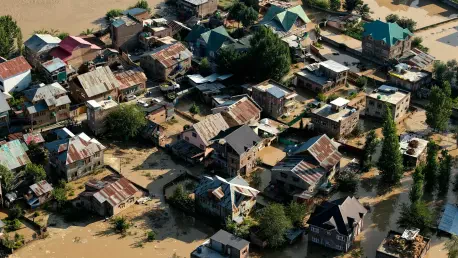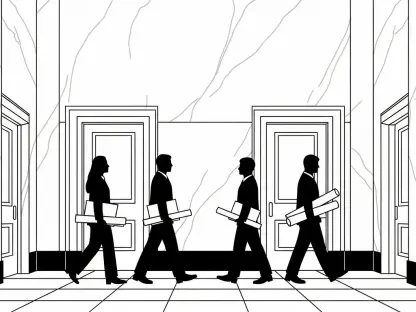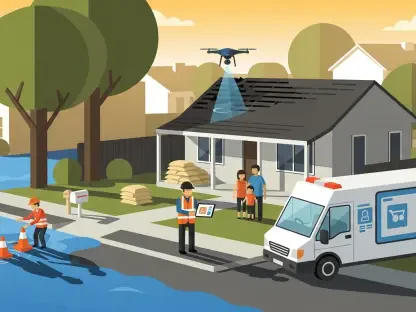In the heart of Texas, a staggering financial storm is brewing, one that threatens to upend the lives of millions of homeowners with a potential loss of over $1 trillion in property value, rooted in the escalating challenges of home insurance. This crisis is not just a local issue but a glaring signal of broader national concerns tied to climate change and economic stability. As extreme weather events become more frequent and severe, the insurance industry is grappling with unprecedented risks, leaving many Texans either uninsured or burdened by skyrocketing premiums. The situation paints a dire picture: homes once considered safe investments are now at the mercy of natural disasters like hurricanes and floods, intensified by global warming. This unfolding disaster raises urgent questions about the future of property ownership in the state and how residents and policymakers can respond to a threat of such immense scale. The stakes could not be higher as Texas stands at the forefront of a national predicament.
The Climate-Driven Insurance Challenge
The core of the home insurance crisis in Texas lies in the undeniable impact of climate change on natural disasters, which have grown more destructive over recent years. Hurricanes, floods, and wildfires, once considered rare or manageable, now strike with alarming regularity and intensity, causing billions in damages. Insurers, faced with mounting losses, are either hiking premiums to levels many homeowners cannot afford or pulling out of high-risk areas altogether. Reports indicate that over $1 trillion in property value is at severe risk in Texas alone, a figure that underscores the magnitude of the problem. This financial strain is not just a burden on individual families but a systemic threat to the state’s housing market. As climate conditions worsen, the cost of protecting homes becomes a barrier, leaving many to face the prospect of catastrophic loss without a safety net. The link between rising temperatures and these escalating risks is clear, making it impossible to ignore the environmental factors at play.
Beyond the raw numbers, the human toll of this crisis reveals a deeper struggle for Texas homeowners caught in the crosshairs of nature’s fury and economic realities. Many residents, particularly in coastal and flood-prone regions, find themselves paying premiums that have surged by roughly 20% in just a few years. For some, coverage has vanished entirely as insurers deem their properties too risky to protect. This leaves families vulnerable, forced to either self-insure at great personal cost or live with the constant fear of losing everything to the next storm. The ripple effects extend to property values, as potential buyers hesitate to invest in areas where insurance is either unaffordable or unavailable. Communities that once thrived on the promise of stability now face uncertainty, with the very foundation of homeownership shaken by forces beyond their control. This situation demands attention, as the consequences are reshaping the landscape of Texas living.
Homeowner Awareness and Risk Perception
A significant barrier to addressing the insurance crisis in Texas is the widespread lack of awareness among homeowners about the true extent of climate-related risks. Many residents, even in highly vulnerable areas, underestimate the likelihood of disasters striking their properties, often assuming that historical patterns will hold. Economists and researchers point to a critical gap between perceived and actual danger, noting that this misjudgment prevents proactive steps like securing comprehensive coverage or investing in protective measures for homes. With over a quarter of American homes at severe risk nationwide, and Texas bearing a disproportionate share of the burden, this disconnect is a major hurdle. Education on the realities of climate-driven threats is essential to shift mindsets and encourage preparation. Without a clear understanding of the stakes, countless families remain exposed to financial ruin, unaware of the looming trillion-dollar shadow over their properties.
Compounding the issue of awareness is the challenge of navigating an increasingly complex insurance landscape in Texas, where options are dwindling and costs are soaring. Homeowners often struggle to find reliable information about their specific risks or the policies that might still be available to them. In the absence of clear guidance, many are left to make critical decisions with incomplete data, sometimes opting for minimal coverage that fails to protect against major disasters. This problem is particularly acute in regions prone to multiple threats, such as flooding and hurricanes, where layered risks amplify the potential for loss. The trillion-dollar exposure in property value is not just a statistic but a reflection of real lives at stake, with each uninsured or underinsured home representing a family on the brink. Bridging this knowledge gap through public outreach and transparent communication from insurers and officials could be a vital step toward mitigating the crisis.
Pathways to Mitigation and Reform
Addressing the home insurance crisis in Texas, with its trillion-dollar implications, requires a multifaceted approach that combines legislative action with individual responsibility. Some states have begun to pave the way, with California introducing laws to tackle coverage gaps after devastating wildfires. Texas could draw inspiration from such efforts, pushing for policies that incentivize insurers to remain in high-risk areas while ensuring premiums remain within reach for most residents. State-level initiatives might include subsidies for vulnerable homeowners or stricter regulations on how insurers assess and price risk. Additionally, federal support could play a role in creating a backstop for catastrophic losses, easing the burden on both insurers and property owners. These systemic changes, while complex, are necessary to safeguard the state’s housing market from collapse under the weight of escalating climate threats.
Equally important is the role of community and homeowner engagement in driving change and building resilience against the insurance crisis. Texans can advocate for stronger protections by reaching out to elected officials, particularly in areas most affected by extreme weather, to demand action on coverage and affordability issues. On a personal level, investing in home fortifications—such as storm-resistant windows or flood barriers—can reduce risk and potentially lower premiums. Understanding the environmental factors fueling these disasters is also crucial, as it empowers residents to make informed choices about where to live and how to prepare. While the trillion-dollar threat looms large, collective efforts to push for reform and individual steps to mitigate risk can create a more sustainable path forward. The focus must remain on actionable solutions that address both the immediate financial strain and the long-term challenges posed by a changing climate.
Reflecting on Past Struggles and Future Solutions
Looking back, Texas grappled with mounting challenges as the home insurance crisis unfolded, with skyrocketing premiums and coverage gaps exposing over $1 trillion in property value to unprecedented risk. The surge in extreme weather events had caught many off guard, leaving homeowners and insurers alike scrambling to adapt to a new reality shaped by climate change. Families faced tough choices, often forgoing adequate protection due to cost, while communities watched property values teeter on the edge of decline. This period revealed the urgent need for systemic reform and greater public awareness, as the state stood as a stark example of the national struggle. Moving forward, the emphasis must shift to innovative policies that balance risk and affordability, alongside robust educational campaigns to equip residents with the tools to protect their homes. Collaborative efforts between government, industry, and citizens offer the best hope for stabilizing the housing market and preventing future crises of this magnitude.









